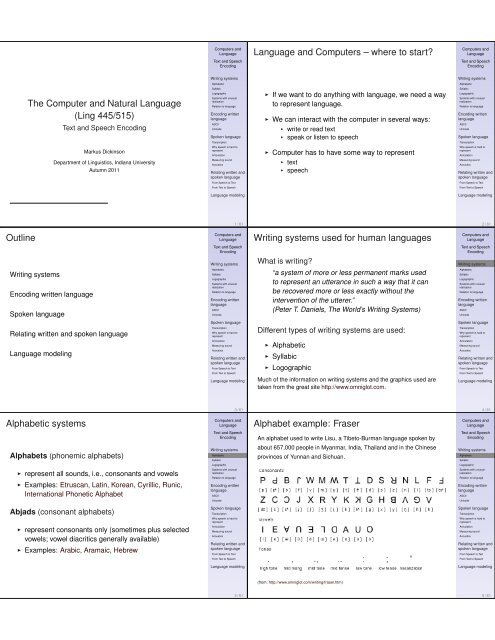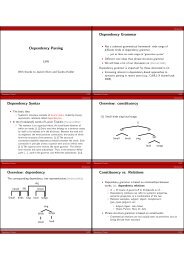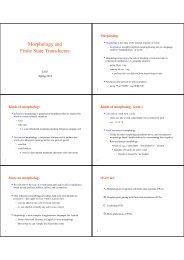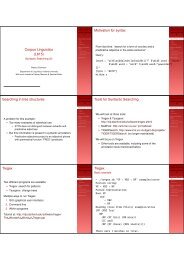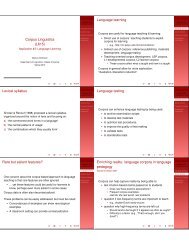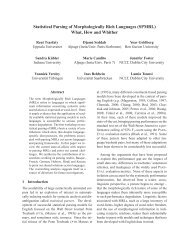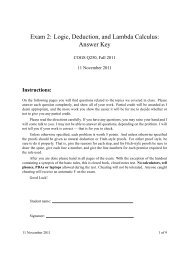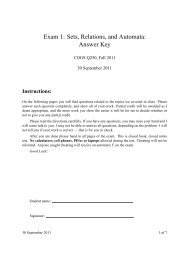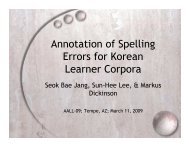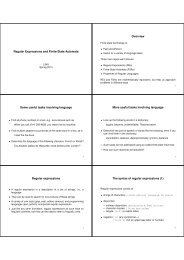Language and Computers - IU Computational Linguistics Program
Language and Computers - IU Computational Linguistics Program
Language and Computers - IU Computational Linguistics Program
Create successful ePaper yourself
Turn your PDF publications into a flip-book with our unique Google optimized e-Paper software.
<strong>Computers</strong> <strong>and</strong><br />
<strong>Language</strong><br />
Text <strong>and</strong> Speech<br />
Encoding<br />
<strong>Language</strong> <strong>and</strong> <strong>Computers</strong> – where to start?<br />
<strong>Computers</strong> <strong>and</strong><br />
<strong>Language</strong><br />
Text <strong>and</strong> Speech<br />
Encoding<br />
Writing systems<br />
Writing systems<br />
Alphabetic<br />
Alphabetic<br />
The Computer <strong>and</strong> Natural <strong>Language</strong><br />
(Ling 445/515)<br />
Text <strong>and</strong> Speech Encoding<br />
Syllabic<br />
Logographic<br />
Systems with unusual<br />
realization<br />
Relation to language<br />
Encoding written<br />
language<br />
ASCII<br />
Unicode<br />
Spoken language<br />
Transcription<br />
◮ If we want to do anything with language, we need a way<br />
to represent language.<br />
◮ We can interact with the computer in several ways:<br />
◮<br />
◮<br />
write or read text<br />
speak or listen to speech<br />
Syllabic<br />
Logographic<br />
Systems with unusual<br />
realization<br />
Relation to language<br />
Encoding written<br />
language<br />
ASCII<br />
Unicode<br />
Spoken language<br />
Transcription<br />
Markus Dickinson<br />
Department of <strong>Linguistics</strong>, Indiana University<br />
Autumn 2011<br />
Why speech is hard to<br />
represent<br />
Articulation<br />
Measuring sound<br />
Acoustics<br />
Relating written <strong>and</strong><br />
spoken language<br />
◮ Computer has to have some way to represent<br />
◮<br />
◮<br />
text<br />
speech<br />
Why speech is hard to<br />
represent<br />
Articulation<br />
Measuring sound<br />
Acoustics<br />
Relating written <strong>and</strong><br />
spoken language<br />
From Speech to Text<br />
From Speech to Text<br />
From Text to Speech<br />
From Text to Speech<br />
<strong>Language</strong> modeling<br />
<strong>Language</strong> modeling<br />
1 / 61<br />
2 / 61<br />
Outline<br />
Writing systems<br />
Encoding written language<br />
Spoken language<br />
Relating written <strong>and</strong> spoken language<br />
<strong>Language</strong> modeling<br />
<strong>Computers</strong> <strong>and</strong><br />
<strong>Language</strong><br />
Text <strong>and</strong> Speech<br />
Encoding<br />
Writing systems<br />
Alphabetic<br />
Syllabic<br />
Logographic<br />
Systems with unusual<br />
realization<br />
Relation to language<br />
Encoding written<br />
language<br />
ASCII<br />
Unicode<br />
Spoken language<br />
Transcription<br />
Why speech is hard to<br />
represent<br />
Articulation<br />
Measuring sound<br />
Acoustics<br />
Relating written <strong>and</strong><br />
spoken language<br />
From Speech to Text<br />
From Text to Speech<br />
<strong>Language</strong> modeling<br />
Writing systems used for human languages<br />
What is writing?<br />
“a system of more or less permanent marks used<br />
to represent an utterance in such a way that it can<br />
be recovered more or less exactly without the<br />
intervention of the utterer.”<br />
(Peter T. Daniels, The World’s Writing Systems)<br />
Different types of writing systems are used:<br />
◮ Alphabetic<br />
◮ Syllabic<br />
◮ Logographic<br />
Much of the information on writing systems <strong>and</strong> the graphics used are<br />
taken from the great site http://www.omniglot.com.<br />
<strong>Computers</strong> <strong>and</strong><br />
<strong>Language</strong><br />
Text <strong>and</strong> Speech<br />
Encoding<br />
Writing systems<br />
Alphabetic<br />
Syllabic<br />
Logographic<br />
Systems with unusual<br />
realization<br />
Relation to language<br />
Encoding written<br />
language<br />
ASCII<br />
Unicode<br />
Spoken language<br />
Transcription<br />
Why speech is hard to<br />
represent<br />
Articulation<br />
Measuring sound<br />
Acoustics<br />
Relating written <strong>and</strong><br />
spoken language<br />
From Speech to Text<br />
From Text to Speech<br />
<strong>Language</strong> modeling<br />
3 / 61<br />
4 / 61<br />
Alphabetic systems<br />
Alphabets (phonemic alphabets)<br />
<strong>Computers</strong> <strong>and</strong><br />
<strong>Language</strong><br />
Text <strong>and</strong> Speech<br />
Encoding<br />
Writing systems<br />
Alphabetic<br />
Syllabic<br />
Alphabet example: Fraser<br />
An alphabet used to write Lisu, a Tibeto-Burman language spoken by<br />
about 657,000 people in Myanmar, India, Thail<strong>and</strong> <strong>and</strong> in the Chinese<br />
provinces of Yunnan <strong>and</strong> Sichuan.<br />
<strong>Computers</strong> <strong>and</strong><br />
<strong>Language</strong><br />
Text <strong>and</strong> Speech<br />
Encoding<br />
Writing systems<br />
Alphabetic<br />
Syllabic<br />
Logographic<br />
Logographic<br />
◮ represent all sounds, i.e., consonants <strong>and</strong> vowels<br />
◮ Examples: Etruscan, Latin, Korean, Cyrillic, Runic,<br />
International Phonetic Alphabet<br />
Systems with unusual<br />
realization<br />
Relation to language<br />
Encoding written<br />
language<br />
ASCII<br />
Unicode<br />
Systems with unusual<br />
realization<br />
Relation to language<br />
Encoding written<br />
language<br />
ASCII<br />
Unicode<br />
Abjads (consonant alphabets)<br />
Spoken language<br />
Transcription<br />
Spoken language<br />
Transcription<br />
◮ represent consonants only (sometimes plus selected<br />
vowels; vowel diacritics generally available)<br />
◮ Examples: Arabic, Aramaic, Hebrew<br />
Why speech is hard to<br />
represent<br />
Articulation<br />
Measuring sound<br />
Acoustics<br />
Relating written <strong>and</strong><br />
spoken language<br />
From Speech to Text<br />
Why speech is hard to<br />
represent<br />
Articulation<br />
Measuring sound<br />
Acoustics<br />
Relating written <strong>and</strong><br />
spoken language<br />
From Speech to Text<br />
From Text to Speech<br />
From Text to Speech<br />
<strong>Language</strong> modeling<br />
<strong>Language</strong> modeling<br />
(from: http://www.omniglot.com/writing/fraser.htm)<br />
5 / 61<br />
6 / 61
Abjad example: Phoenician<br />
An abjad used to write Phoenician, created between the 18th <strong>and</strong> 17th<br />
centuries BC; assumed to be the forerunner of the Greek <strong>and</strong> Hebrew<br />
alphabet.<br />
<strong>Computers</strong> <strong>and</strong><br />
<strong>Language</strong><br />
Text <strong>and</strong> Speech<br />
Encoding<br />
Writing systems<br />
Alphabetic<br />
Syllabic<br />
A note on the letter-sound correspondence<br />
◮ Alphabets use letters to encode sounds (consonants,<br />
vowels).<br />
<strong>Computers</strong> <strong>and</strong><br />
<strong>Language</strong><br />
Text <strong>and</strong> Speech<br />
Encoding<br />
Writing systems<br />
Alphabetic<br />
Syllabic<br />
Logographic<br />
Systems with unusual<br />
realization<br />
Relation to language<br />
Encoding written<br />
language<br />
◮ But the correspondence between spelling <strong>and</strong><br />
pronunciation in many languages is quite complex, i.e.,<br />
not a simple one-to-one correspondence.<br />
Logographic<br />
Systems with unusual<br />
realization<br />
Relation to language<br />
Encoding written<br />
language<br />
ASCII<br />
Unicode<br />
◮ Example: English<br />
ASCII<br />
Unicode<br />
(from: http://www.omniglot.com/writing/phoenician.htm)<br />
Spoken language<br />
Transcription<br />
Why speech is hard to<br />
represent<br />
Articulation<br />
Measuring sound<br />
Acoustics<br />
Relating written <strong>and</strong><br />
spoken language<br />
From Speech to Text<br />
From Text to Speech<br />
<strong>Language</strong> modeling<br />
◮<br />
◮<br />
◮<br />
◮<br />
◮<br />
same spelling – different sounds: ough: ought, cough,<br />
tough, through, though, hiccough<br />
silent letters: knee, knight, knife, debt, psychology,<br />
mortgage<br />
one letter – multiple sounds: exit, use<br />
multiple letters – one sound: the, revolution<br />
alternate spellings: jail or gaol; but not possible seagh<br />
for chef (despite sure, dead, laugh)<br />
Spoken language<br />
Transcription<br />
Why speech is hard to<br />
represent<br />
Articulation<br />
Measuring sound<br />
Acoustics<br />
Relating written <strong>and</strong><br />
spoken language<br />
From Speech to Text<br />
From Text to Speech<br />
<strong>Language</strong> modeling<br />
7 / 61<br />
8 / 61<br />
More examples for non-transparent letter-sound<br />
correspondences<br />
<strong>Computers</strong> <strong>and</strong><br />
<strong>Language</strong><br />
Text <strong>and</strong> Speech<br />
Encoding<br />
The International Phonetic Alphabet (IPA)<br />
<strong>Computers</strong> <strong>and</strong><br />
<strong>Language</strong><br />
Text <strong>and</strong> Speech<br />
Encoding<br />
French<br />
(1) a. Versailles → [veRsai]<br />
Irish<br />
b. ete, etais, etait, etaient → [ete]<br />
(2) a. Baile A’tha Cliath (Dublin) → [bl’a: kli uh]<br />
b. samhradh (summer) → [sauruh]<br />
c. scri’obhaim (I write) → [shgri:m]<br />
Writing systems<br />
Alphabetic<br />
Syllabic<br />
Logographic<br />
Systems with unusual<br />
realization<br />
Relation to language<br />
Encoding written<br />
language<br />
ASCII<br />
Unicode<br />
Spoken language<br />
Transcription<br />
Why speech is hard to<br />
represent<br />
Articulation<br />
Measuring sound<br />
Acoustics<br />
Relating written <strong>and</strong><br />
spoken language<br />
From Speech to Text<br />
From Text to Speech<br />
◮ Several special alphabets for representing sounds have<br />
been developed, the best known being the International<br />
Phonetic Alphabet (IPA).<br />
◮ The phonetic symbols are unambiguous:<br />
◮ designed so that each speech sound gets its own<br />
symbol,<br />
◮ eliminating the need for<br />
◮<br />
◮<br />
multiple symbols used to represent simple sounds<br />
one symbol being used for multiple sounds.<br />
◮ Interactive example chart: http://web.uvic.ca/ling/<br />
resources/ipa/charts/IPAlab/IPAlab.htm<br />
Writing systems<br />
Alphabetic<br />
Syllabic<br />
Logographic<br />
Systems with unusual<br />
realization<br />
Relation to language<br />
Encoding written<br />
language<br />
ASCII<br />
Unicode<br />
Spoken language<br />
Transcription<br />
Why speech is hard to<br />
represent<br />
Articulation<br />
Measuring sound<br />
Acoustics<br />
Relating written <strong>and</strong><br />
spoken language<br />
From Speech to Text<br />
From Text to Speech<br />
What is the notation used within the []?<br />
<strong>Language</strong> modeling<br />
<strong>Language</strong> modeling<br />
9 / 61<br />
10 / 61<br />
Syllabic systems<br />
Syllabic alphabets (Alphasyllabaries)<br />
◮ writing systems with symbols that represent a<br />
consonant with a vowel, but the vowel can be changed<br />
by adding a diacritic (= a symbol added to the letter).<br />
◮ Examples: Balinese, Javanese, Tibetan, Tamil, Thai,<br />
Tagalog<br />
(cf. also: http://www.omniglot.com/writing/syllabic.htm)<br />
<strong>Computers</strong> <strong>and</strong><br />
<strong>Language</strong><br />
Text <strong>and</strong> Speech<br />
Encoding<br />
Writing systems<br />
Alphabetic<br />
Syllabic<br />
Logographic<br />
Systems with unusual<br />
realization<br />
Relation to language<br />
Encoding written<br />
language<br />
ASCII<br />
Unicode<br />
Spoken language<br />
Syllabary example: Cypriot<br />
The Cypriot syllabary or Cypro-Minoan writing is thought to have<br />
developed from the Linear A, or possibly the Linear B script of Crete,<br />
though its exact origins are not known. It was used from about 800 to 200<br />
BC.<br />
<strong>Computers</strong> <strong>and</strong><br />
<strong>Language</strong><br />
Text <strong>and</strong> Speech<br />
Encoding<br />
Writing systems<br />
Alphabetic<br />
Syllabic<br />
Logographic<br />
Systems with unusual<br />
realization<br />
Relation to language<br />
Encoding written<br />
language<br />
ASCII<br />
Unicode<br />
Spoken language<br />
Transcription<br />
Transcription<br />
Syllabaries<br />
Why speech is hard to<br />
represent<br />
Articulation<br />
Why speech is hard to<br />
represent<br />
Articulation<br />
◮ writing systems with separate symbols for each syllable<br />
of a language<br />
◮ Examples: Cherokee. Ethiopic, Cypriot, Ojibwe,<br />
Hiragana (Japanese)<br />
Measuring sound<br />
Acoustics<br />
Relating written <strong>and</strong><br />
spoken language<br />
From Speech to Text<br />
From Text to Speech<br />
<strong>Language</strong> modeling<br />
Measuring sound<br />
Acoustics<br />
Relating written <strong>and</strong><br />
spoken language<br />
From Speech to Text<br />
From Text to Speech<br />
<strong>Language</strong> modeling<br />
(cf. also: http://www.omniglot.com/writing/syllabaries.htm#syll)<br />
(from: http://www.omniglot.com/writing/cypriot.htm)<br />
11 / 61<br />
12 / 61
Syllabic alphabet example: Lao<br />
Script developed in the 14th century to write the Lao language, based on<br />
an early version of the Thai script, which was developed from the Old<br />
Khmer script, which was itself based on Mon scripts.<br />
Example for vowel diacritics around the letter k:<br />
<strong>Computers</strong> <strong>and</strong><br />
<strong>Language</strong><br />
Text <strong>and</strong> Speech<br />
Encoding<br />
Writing systems<br />
Alphabetic<br />
Syllabic<br />
Logographic<br />
Systems with unusual<br />
realization<br />
Relation to language<br />
Encoding written<br />
language<br />
Logographic writing systems<br />
◮ Logographs (also called Logograms):<br />
◮<br />
Pictographs (Pictograms): originally pictures of<br />
things, now stylized <strong>and</strong> simplified.<br />
Example: development of Chinese character horse:<br />
<strong>Computers</strong> <strong>and</strong><br />
<strong>Language</strong><br />
Text <strong>and</strong> Speech<br />
Encoding<br />
Writing systems<br />
Alphabetic<br />
Syllabic<br />
Logographic<br />
Systems with unusual<br />
realization<br />
Relation to language<br />
Encoding written<br />
language<br />
ASCII<br />
ASCII<br />
Unicode<br />
Unicode<br />
Spoken language<br />
Transcription<br />
Why speech is hard to<br />
represent<br />
Articulation<br />
Measuring sound<br />
Acoustics<br />
Relating written <strong>and</strong><br />
spoken language<br />
From Speech to Text<br />
◮<br />
◮<br />
◮<br />
Ideographs (Ideograms): representations of abstract<br />
ideas<br />
Compounds: combinations of two or more logographs.<br />
Semantic-phonetic compounds: symbols with a<br />
meaning element (hints at meaning) <strong>and</strong> a phonetic<br />
element (hints at pronunciation).<br />
Spoken language<br />
Transcription<br />
Why speech is hard to<br />
represent<br />
Articulation<br />
Measuring sound<br />
Acoustics<br />
Relating written <strong>and</strong><br />
spoken language<br />
From Speech to Text<br />
(from: http://www.omniglot.com/writing/lao.htm)<br />
From Text to Speech<br />
<strong>Language</strong> modeling<br />
◮ Examples: Chinese (Zhōngwén), Japanese (Nihongo),<br />
Mayan, Vietnamese, Ancient Egyptian<br />
From Text to Speech<br />
<strong>Language</strong> modeling<br />
13 / 61<br />
14 / 61<br />
Logograph writing system example: Chinese<br />
Pictographs<br />
<strong>Computers</strong> <strong>and</strong><br />
<strong>Language</strong><br />
Text <strong>and</strong> Speech<br />
Encoding<br />
Writing systems<br />
Semantic-phonetic compounds<br />
<strong>Computers</strong> <strong>and</strong><br />
<strong>Language</strong><br />
Text <strong>and</strong> Speech<br />
Encoding<br />
Writing systems<br />
Alphabetic<br />
Alphabetic<br />
Syllabic<br />
Syllabic<br />
Logographic<br />
Logographic<br />
Systems with unusual<br />
realization<br />
Systems with unusual<br />
realization<br />
Ideographs<br />
Relation to language<br />
Encoding written<br />
language<br />
Relation to language<br />
Encoding written<br />
language<br />
ASCII<br />
ASCII<br />
Unicode<br />
Unicode<br />
Spoken language<br />
Spoken language<br />
Transcription<br />
Transcription<br />
Why speech is hard to<br />
represent<br />
Why speech is hard to<br />
represent<br />
Compounds of Pictographs/Ideographs<br />
Articulation<br />
Measuring sound<br />
Acoustics<br />
Relating written <strong>and</strong><br />
spoken language<br />
An example from Ancient Egyptian<br />
Articulation<br />
Measuring sound<br />
Acoustics<br />
Relating written <strong>and</strong><br />
spoken language<br />
From Speech to Text<br />
From Speech to Text<br />
From Text to Speech<br />
From Text to Speech<br />
<strong>Language</strong> modeling<br />
<strong>Language</strong> modeling<br />
(from: http://www.omniglot.com/writing/chinese types.htm)<br />
(from: http://www.omniglot.com/writing/egyptian.htm)<br />
15 / 61<br />
16 / 61<br />
Two writing systems with unusual realization<br />
Tactile<br />
◮ Braille is a writing system that makes it possible to read<br />
<strong>and</strong> write through touch; primarily used by the (partially)<br />
blind.<br />
◮ It uses patterns of raised dots arranged in cells of up to<br />
six dots in a 3 x 2 configuration.<br />
◮ Each pattern represents a character, but some frequent<br />
words <strong>and</strong> letter combinations have their own pattern.<br />
<strong>Computers</strong> <strong>and</strong><br />
<strong>Language</strong><br />
Text <strong>and</strong> Speech<br />
Encoding<br />
Writing systems<br />
Alphabetic<br />
Syllabic<br />
Logographic<br />
Systems with unusual<br />
realization<br />
Relation to language<br />
Encoding written<br />
language<br />
ASCII<br />
Unicode<br />
Spoken language<br />
Transcription<br />
Why speech is hard to<br />
represent<br />
Braille alphabet<br />
<strong>Computers</strong> <strong>and</strong><br />
<strong>Language</strong><br />
Text <strong>and</strong> Speech<br />
Encoding<br />
Writing systems<br />
Alphabetic<br />
Syllabic<br />
Logographic<br />
Systems with unusual<br />
realization<br />
Relation to language<br />
Encoding written<br />
language<br />
ASCII<br />
Unicode<br />
Spoken language<br />
Transcription<br />
Why speech is hard to<br />
represent<br />
Chromatographic<br />
Articulation<br />
Measuring sound<br />
Acoustics<br />
Articulation<br />
Measuring sound<br />
Acoustics<br />
◮ The Benin <strong>and</strong> Edo people in southern Nigeria have<br />
supposedly developed a system of writing based on<br />
different color combinations <strong>and</strong> symbols.<br />
Relating written <strong>and</strong><br />
spoken language<br />
From Speech to Text<br />
From Text to Speech<br />
<strong>Language</strong> modeling<br />
Relating written <strong>and</strong><br />
spoken language<br />
From Speech to Text<br />
From Text to Speech<br />
<strong>Language</strong> modeling<br />
(cf. http://www.library.cornell.edu/africana/Writing Systems/Chroma.html)<br />
17 / 61<br />
18 / 61
Chromatographic system<br />
<strong>Computers</strong> <strong>and</strong><br />
<strong>Language</strong><br />
Text <strong>and</strong> Speech<br />
Encoding<br />
Relating writing systems to languages<br />
<strong>Computers</strong> <strong>and</strong><br />
<strong>Language</strong><br />
Text <strong>and</strong> Speech<br />
Encoding<br />
Writing systems<br />
Writing systems<br />
Alphabetic<br />
Alphabetic<br />
Syllabic<br />
Logographic<br />
Systems with unusual<br />
realization<br />
Relation to language<br />
Encoding written<br />
language<br />
ASCII<br />
Unicode<br />
◮ There is not a simple correspondence between a<br />
writing system <strong>and</strong> a language.<br />
◮ For example, English uses the Roman alphabet, but<br />
Arabic numerals (e.g., 3 <strong>and</strong> 4 instead of III <strong>and</strong> IV).<br />
Syllabic<br />
Logographic<br />
Systems with unusual<br />
realization<br />
Relation to language<br />
Encoding written<br />
language<br />
ASCII<br />
Unicode<br />
Spoken language<br />
Transcription<br />
Why speech is hard to<br />
represent<br />
Articulation<br />
Measuring sound<br />
Acoustics<br />
Relating written <strong>and</strong><br />
spoken language<br />
◮ We’ll look at three other examples:<br />
◮<br />
◮<br />
◮<br />
Japanese<br />
Korean<br />
Azeri<br />
Spoken language<br />
Transcription<br />
Why speech is hard to<br />
represent<br />
Articulation<br />
Measuring sound<br />
Acoustics<br />
Relating written <strong>and</strong><br />
spoken language<br />
From Speech to Text<br />
From Speech to Text<br />
From Text to Speech<br />
From Text to Speech<br />
<strong>Language</strong> modeling<br />
<strong>Language</strong> modeling<br />
19 / 61<br />
20 / 61<br />
Japanese<br />
<strong>Computers</strong> <strong>and</strong><br />
<strong>Language</strong><br />
Text <strong>and</strong> Speech<br />
Encoding<br />
Korean<br />
<strong>Computers</strong> <strong>and</strong><br />
<strong>Language</strong><br />
Text <strong>and</strong> Speech<br />
Encoding<br />
Japanese: logographic system kanji, syllabary katakana,<br />
syllabary hiragana<br />
◮ kanji: 5,000-10,000 borrowed Chinese characters<br />
◮ katakana<br />
◮ used mainly for non-Chinese loan words, onomatopoeic<br />
words, foreign names, <strong>and</strong> for emphasis<br />
◮ hiragana<br />
◮ originally used only by women (10th century), but<br />
codified in 1946 with 48 syllables<br />
◮ used mainly for word endings, kids’ books, <strong>and</strong> for<br />
words with obscure kanji symbols<br />
◮ romaji: Roman characters<br />
Writing systems<br />
Alphabetic<br />
Syllabic<br />
Logographic<br />
Systems with unusual<br />
realization<br />
Relation to language<br />
Encoding written<br />
language<br />
ASCII<br />
Unicode<br />
Spoken language<br />
Transcription<br />
Why speech is hard to<br />
represent<br />
Articulation<br />
Measuring sound<br />
Acoustics<br />
Relating written <strong>and</strong><br />
spoken language<br />
From Speech to Text<br />
From Text to Speech<br />
“Korean writing is an alphabet, a syllabary <strong>and</strong> logographs<br />
all at once.” (http://home.vicnet.net.au/ ∼ ozideas/writkor.htm)<br />
◮ The hangul system was developed in 1444 during King<br />
Sejong’s reign.<br />
◮ There are 24 letters: 14 consonants <strong>and</strong> 10 vowels<br />
◮ But the letters are grouped into syllables, i.e. the letters<br />
in a syllable are not written separately as in the English<br />
system, but together form a single character.<br />
E.g., “Hangeul” (from: http://www.omniglot.com/writing/korean.htm):<br />
◮ In South Korea, hanja (logographic Chinese characters)<br />
are also used.<br />
Writing systems<br />
Alphabetic<br />
Syllabic<br />
Logographic<br />
Systems with unusual<br />
realization<br />
Relation to language<br />
Encoding written<br />
language<br />
ASCII<br />
Unicode<br />
Spoken language<br />
Transcription<br />
Why speech is hard to<br />
represent<br />
Articulation<br />
Measuring sound<br />
Acoustics<br />
Relating written <strong>and</strong><br />
spoken language<br />
From Speech to Text<br />
From Text to Speech<br />
<strong>Language</strong> modeling<br />
<strong>Language</strong> modeling<br />
21 / 61<br />
22 / 61<br />
Azeri<br />
A Turkish language with speakers in Azerbaijan, northwest<br />
Iran, <strong>and</strong> (former Soviet) Georgia<br />
◮ 7th century until 1920s: Arabic scripts. Three different<br />
Arabic scripts used<br />
◮ 1929: Latin alphabet enforced by Soviets to reduce<br />
Islamic influence.<br />
◮ 1939: Cyrillic alphabet enforced by Stalin<br />
◮ 1991: Back to Latin alphabet, but slightly different than<br />
before.<br />
→ Latin typewriters <strong>and</strong> computer fonts were in great<br />
dem<strong>and</strong> in 1991<br />
<strong>Computers</strong> <strong>and</strong><br />
<strong>Language</strong><br />
Text <strong>and</strong> Speech<br />
Encoding<br />
Writing systems<br />
Alphabetic<br />
Syllabic<br />
Logographic<br />
Systems with unusual<br />
realization<br />
Relation to language<br />
Encoding written<br />
language<br />
ASCII<br />
Unicode<br />
Spoken language<br />
Transcription<br />
Why speech is hard to<br />
represent<br />
Articulation<br />
Measuring sound<br />
Acoustics<br />
Relating written <strong>and</strong><br />
spoken language<br />
From Speech to Text<br />
From Text to Speech<br />
<strong>Language</strong> modeling<br />
Encoding written language<br />
◮ Information on a computer is stored in bits.<br />
◮ A bit is either on (= 1, yes) or off (= 0, no).<br />
◮ A list of 8 bits makes up a byte, e.g., 01001010<br />
◮ Just like with the base 10 numbers we’re used to, the<br />
order of the bits in a byte matters:<br />
◮ Big Endian: most important bit is leftmost (the st<strong>and</strong>ard<br />
way of doing things)<br />
◮<br />
◮<br />
◮<br />
The positions in a byte thus encode:<br />
128 64 32 16 8 4 2 1<br />
“There are 10 kinds of people in the world; those who<br />
know binary <strong>and</strong> those who don’t”<br />
(from: http://www.wlug.org.nz/LittleEndian)<br />
Little Endian: most important bit is rightmost (only<br />
used on Intel machines)<br />
◮<br />
The positions in a byte thus encode:<br />
1 2 4 8 16 32 64 128<br />
<strong>Computers</strong> <strong>and</strong><br />
<strong>Language</strong><br />
Text <strong>and</strong> Speech<br />
Encoding<br />
Writing systems<br />
Alphabetic<br />
Syllabic<br />
Logographic<br />
Systems with unusual<br />
realization<br />
Relation to language<br />
Encoding written<br />
language<br />
ASCII<br />
Unicode<br />
Spoken language<br />
Transcription<br />
Why speech is hard to<br />
represent<br />
Articulation<br />
Measuring sound<br />
Acoustics<br />
Relating written <strong>and</strong><br />
spoken language<br />
From Speech to Text<br />
From Text to Speech<br />
<strong>Language</strong> modeling<br />
23 / 61<br />
24 / 61
Converting decimal numbers to binary<br />
Tabular Method<br />
<strong>Computers</strong> <strong>and</strong><br />
<strong>Language</strong><br />
Text <strong>and</strong> Speech<br />
Encoding<br />
Converting decimal numbers to binary<br />
Division Method<br />
<strong>Computers</strong> <strong>and</strong><br />
<strong>Language</strong><br />
Text <strong>and</strong> Speech<br />
Encoding<br />
Writing systems<br />
Writing systems<br />
Alphabetic<br />
Alphabetic<br />
Using the first 4 bits, we want to know how to write 10 in bit<br />
(or binary) notation.<br />
8 4 2 1<br />
? ? ? ?<br />
8 < 10 ? ? ?<br />
1 8 + 4 = 12 > 10 ? ?<br />
1 0 8 + 2 = 10 ?<br />
1 0 1 0<br />
Syllabic<br />
Logographic<br />
Systems with unusual<br />
realization<br />
Relation to language<br />
Encoding written<br />
language<br />
ASCII<br />
Unicode<br />
Spoken language<br />
Transcription<br />
Why speech is hard to<br />
represent<br />
Articulation<br />
Measuring sound<br />
Acoustics<br />
Relating written <strong>and</strong><br />
spoken language<br />
Decimal Remainder? Binary<br />
10/2 = 5 no 0<br />
5/2 = 2 yes 10<br />
2/2 = 1 no 010<br />
1/2 = 0 yes 1010<br />
Syllabic<br />
Logographic<br />
Systems with unusual<br />
realization<br />
Relation to language<br />
Encoding written<br />
language<br />
ASCII<br />
Unicode<br />
Spoken language<br />
Transcription<br />
Why speech is hard to<br />
represent<br />
Articulation<br />
Measuring sound<br />
Acoustics<br />
Relating written <strong>and</strong><br />
spoken language<br />
From Speech to Text<br />
From Speech to Text<br />
From Text to Speech<br />
From Text to Speech<br />
<strong>Language</strong> modeling<br />
<strong>Language</strong> modeling<br />
25 / 61<br />
26 / 61<br />
An encoding st<strong>and</strong>ard: ASCII<br />
With 8 bits (a single byte), you can represent 256 different<br />
characters.<br />
◮ With 256 possible characters, we can store:<br />
◮ every single letter used in English,<br />
◮ plus all the things like commas, periods, space bar,<br />
percent sign (%), back space, <strong>and</strong> so on.<br />
ASCII = the American St<strong>and</strong>ard Code for Information<br />
Interchange<br />
◮ 7-bit code for storing English text<br />
◮ 7 bits = 128 possible characters.<br />
◮ The numeric order reflects alphabetic ordering.<br />
<strong>Computers</strong> <strong>and</strong><br />
<strong>Language</strong><br />
Text <strong>and</strong> Speech<br />
Encoding<br />
Writing systems<br />
Alphabetic<br />
Syllabic<br />
Logographic<br />
Systems with unusual<br />
realization<br />
Relation to language<br />
Encoding written<br />
language<br />
ASCII<br />
Unicode<br />
Spoken language<br />
Transcription<br />
Why speech is hard to<br />
represent<br />
Articulation<br />
Measuring sound<br />
Acoustics<br />
Relating written <strong>and</strong><br />
spoken language<br />
From Speech to Text<br />
From Text to Speech<br />
<strong>Language</strong> modeling<br />
The ASCII chart<br />
Codes 1–31 are used for control characters (backspace, line<br />
feed, tab, . . . ).<br />
32<br />
33 !<br />
34 “<br />
35 #<br />
36 $<br />
37 %<br />
38 &<br />
39 ’<br />
40 (<br />
41 )<br />
42 *<br />
43 +<br />
44 ,<br />
45 -<br />
46 .<br />
47 /<br />
48 0<br />
49 1<br />
50 2<br />
51 3<br />
52 4<br />
53 5<br />
54 6<br />
55 7<br />
56 8<br />
57 9<br />
58 :<br />
59 ;<br />
60 <<br />
61 =<br />
62 ><br />
63 ?<br />
64 @<br />
65 A<br />
66 B<br />
67 C<br />
68 D<br />
69 E<br />
70 F<br />
71 G<br />
72 H<br />
73 I<br />
74 J<br />
75 K<br />
76 L<br />
77 M<br />
78 N<br />
79 O<br />
80 P<br />
81 Q<br />
82 R<br />
83 S<br />
84 T<br />
85 U<br />
86 V<br />
87 W<br />
88 X<br />
89 Y<br />
90 Z<br />
91 [<br />
92 \<br />
93 ]<br />
94 ^<br />
95 _<br />
96 ‘<br />
97 a<br />
98 b<br />
99 c<br />
100 d<br />
101 e<br />
102 f<br />
103 g<br />
104 h<br />
105 i<br />
106 j<br />
107 k<br />
108 l<br />
109 m<br />
110 n<br />
111 o<br />
112 p<br />
113 q<br />
114 r<br />
115 s<br />
116 t<br />
117 u<br />
118 v<br />
119 w<br />
120 x<br />
121 y<br />
122 z<br />
123 {<br />
124 —<br />
125 }<br />
126 ˜<br />
127 DEL<br />
<strong>Computers</strong> <strong>and</strong><br />
<strong>Language</strong><br />
Text <strong>and</strong> Speech<br />
Encoding<br />
Writing systems<br />
Alphabetic<br />
Syllabic<br />
Logographic<br />
Systems with unusual<br />
realization<br />
Relation to language<br />
Encoding written<br />
language<br />
ASCII<br />
Unicode<br />
Spoken language<br />
Transcription<br />
Why speech is hard to<br />
represent<br />
Articulation<br />
Measuring sound<br />
Acoustics<br />
Relating written <strong>and</strong><br />
spoken language<br />
From Speech to Text<br />
From Text to Speech<br />
<strong>Language</strong> modeling<br />
27 / 61<br />
28 / 61<br />
E-mail issues<br />
<strong>Computers</strong> <strong>and</strong><br />
<strong>Language</strong><br />
Text <strong>and</strong> Speech<br />
Encoding<br />
Different coding systems<br />
<strong>Computers</strong> <strong>and</strong><br />
<strong>Language</strong><br />
Text <strong>and</strong> Speech<br />
Encoding<br />
◮ Mail sent on the internet used to only be able to transfer<br />
the 7-bit ASCII messages. But now we can detect the<br />
incoming character set <strong>and</strong> adjust the input.<br />
◮ Note that this is an example of meta-information =<br />
information which is printed as part of the regular<br />
message, but tells us something about that message.<br />
◮ Multipurpose Internet Mail Extensions (MIME) provides<br />
meta-information on the text, which tells us:<br />
◮<br />
◮<br />
◮<br />
which version of MIME is being used<br />
what the charcter set is<br />
if that character set was altered, how it was altered<br />
Mime-Version: 1.0 Content-Type: text/plain;<br />
Writing systems<br />
Alphabetic<br />
Syllabic<br />
Logographic<br />
Systems with unusual<br />
realization<br />
Relation to language<br />
Encoding written<br />
language<br />
ASCII<br />
Unicode<br />
Spoken language<br />
Transcription<br />
Why speech is hard to<br />
represent<br />
Articulation<br />
Measuring sound<br />
Acoustics<br />
Relating written <strong>and</strong><br />
spoken language<br />
From Speech to Text<br />
From Text to Speech<br />
But wait, didn’t we want to be able to encode all languages?<br />
There are ways ...<br />
◮ Extend the ASCII system with various other systems,<br />
for example:<br />
◮<br />
◮<br />
◮<br />
◮<br />
ISO 8859-1: includes extra letters needed for French,<br />
German, Spanish, etc.<br />
ISO 8859-7: Greek alphabet<br />
ISO 8859-8: Hebrew alphabet<br />
JIS X 0208: Japanese characters<br />
◮ Have one system for everything → Unicode<br />
Writing systems<br />
Alphabetic<br />
Syllabic<br />
Logographic<br />
Systems with unusual<br />
realization<br />
Relation to language<br />
Encoding written<br />
language<br />
ASCII<br />
Unicode<br />
Spoken language<br />
Transcription<br />
Why speech is hard to<br />
represent<br />
Articulation<br />
Measuring sound<br />
Acoustics<br />
Relating written <strong>and</strong><br />
spoken language<br />
From Speech to Text<br />
From Text to Speech<br />
charset=US-ASCII Content-Transfer-Encoding:<br />
7bit<br />
<strong>Language</strong> modeling<br />
<strong>Language</strong> modeling<br />
29 / 61<br />
30 / 61
Unicode<br />
<strong>Computers</strong> <strong>and</strong><br />
<strong>Language</strong><br />
Text <strong>and</strong> Speech<br />
Encoding<br />
How big is Unicode?<br />
<strong>Computers</strong> <strong>and</strong><br />
<strong>Language</strong><br />
Text <strong>and</strong> Speech<br />
Encoding<br />
Problems with having multiple encoding systems:<br />
Writing systems<br />
Writing systems<br />
◮ Conflicts: two encodings can use:<br />
◮ same number for two different characters<br />
◮ different numbers for the same character<br />
◮ Hassle: have to install many, many systems if you want<br />
to be able to deal with various languages<br />
Unicode tries to fix that by having a single representation for<br />
every possible character.<br />
“Unicode provides a unique number for every<br />
character, no matter what the platform, no matter<br />
what the program, no matter what the language.”<br />
(www.unicode.org)<br />
Alphabetic<br />
Syllabic<br />
Logographic<br />
Systems with unusual<br />
realization<br />
Relation to language<br />
Encoding written<br />
language<br />
ASCII<br />
Unicode<br />
Spoken language<br />
Transcription<br />
Why speech is hard to<br />
represent<br />
Articulation<br />
Measuring sound<br />
Acoustics<br />
Relating written <strong>and</strong><br />
spoken language<br />
From Speech to Text<br />
From Text to Speech<br />
<strong>Language</strong> modeling<br />
Version 3.2 has codes for 95,221 characters from alphabets,<br />
syllabaries <strong>and</strong> logographic systems.<br />
◮ Uses 32 bits – meaning we can store<br />
2 32 = 4, 294, 967, 296 characters.<br />
◮ 4 billion possibilities for each character? That takes a lot<br />
of space on the computer!<br />
Alphabetic<br />
Syllabic<br />
Logographic<br />
Systems with unusual<br />
realization<br />
Relation to language<br />
Encoding written<br />
language<br />
ASCII<br />
Unicode<br />
Spoken language<br />
Transcription<br />
Why speech is hard to<br />
represent<br />
Articulation<br />
Measuring sound<br />
Acoustics<br />
Relating written <strong>and</strong><br />
spoken language<br />
From Speech to Text<br />
From Text to Speech<br />
<strong>Language</strong> modeling<br />
Compact encoding of Unicode characters<br />
◮ Unicode has three versions<br />
◮ UTF-32 (32 bits): direct representation<br />
◮ UTF-16 (16 bits): 2 16 = 65536<br />
◮ UTF-8 (8 bits): 2 8 = 256<br />
◮ How is it possible to encode 2 32 possibilities in 8 bits<br />
(UTF-8)?<br />
◮<br />
◮<br />
◮<br />
Several bytes are used to represent one character.<br />
Use the highest bit as flag:<br />
◮<br />
◮<br />
highest bit 0: single character<br />
highest bit 1: part of a multi byte character<br />
Nice consequence: ASCII text is in a valid UTF-8<br />
encoding.<br />
Unwritten languages<br />
31 / 61<br />
<strong>Computers</strong> <strong>and</strong><br />
<strong>Language</strong><br />
Text <strong>and</strong> Speech<br />
Encoding<br />
Writing systems<br />
Alphabetic<br />
Syllabic<br />
Logographic<br />
Systems with unusual<br />
realization<br />
Relation to language<br />
Encoding written<br />
language<br />
ASCII<br />
Unicode<br />
Spoken language<br />
Transcription<br />
Why speech is hard to<br />
represent<br />
Articulation<br />
Measuring sound<br />
Acoustics<br />
Relating written <strong>and</strong><br />
spoken language<br />
From Speech to Text<br />
From Text to Speech<br />
<strong>Language</strong> modeling<br />
33 / 61<br />
<strong>Computers</strong> <strong>and</strong><br />
<strong>Language</strong><br />
Text <strong>and</strong> Speech<br />
Encoding<br />
UTF-8 details<br />
◮ First byte unambiguously tells you how many bytes to<br />
expect after it<br />
◮ e.g., first byte of 11110xxx has a four total bytes<br />
◮ all non-starting bytes start with 10 = not the initial byte<br />
Byte 1 Byte 2 Byte 3 Byte 4 Byte 5 Byte 6<br />
0xxxxxxx<br />
110xxxxx 10xxxxxx<br />
1110xxxx 10xxxxxx 10xxxxxx<br />
11110xxx 10xxxxxx 10xxxxxx 10xxxxxx<br />
111110xx 10xxxxxx 10xxxxxx 10xxxxxx 10xxxxxx<br />
1111110x 10xxxxxx 10xxxxxx 10xxxxxx 10xxxxxx 10xxxxxx<br />
Example: Greek α (‘alpha’) has a code value of 945<br />
◮ Binary: 11 10110001<br />
◮ 11 10110001 = 011 10110001 = 01110 110001<br />
◮ Insert these numbers into x’s in the second row:<br />
11001110 10110001<br />
The need for speech<br />
32 / 61<br />
<strong>Computers</strong> <strong>and</strong><br />
<strong>Language</strong><br />
Text <strong>and</strong> Speech<br />
Encoding<br />
Writing systems<br />
Alphabetic<br />
Syllabic<br />
Logographic<br />
Systems with unusual<br />
realization<br />
Relation to language<br />
Encoding written<br />
language<br />
ASCII<br />
Unicode<br />
Spoken language<br />
Transcription<br />
Why speech is hard to<br />
represent<br />
Articulation<br />
Measuring sound<br />
Acoustics<br />
Relating written <strong>and</strong><br />
spoken language<br />
From Speech to Text<br />
From Text to Speech<br />
<strong>Language</strong> modeling<br />
34 / 61<br />
<strong>Computers</strong> <strong>and</strong><br />
<strong>Language</strong><br />
Text <strong>and</strong> Speech<br />
Encoding<br />
Many languages have never been written down. Of the 6912<br />
spoken languages, approximately 3000 have never been<br />
written down.<br />
Some examples:<br />
◮ Salar, a Turkic language in China.<br />
◮ Gugu Badhun, a language in Australia.<br />
◮ Southeastern Pomo, a language in California<br />
(See: http://www.ethnologue.com/ <strong>and</strong> http://www.sil.org/mexico/ilv/iinfoilvmexico.htm)<br />
Writing systems<br />
Alphabetic<br />
Syllabic<br />
Logographic<br />
Systems with unusual<br />
realization<br />
Relation to language<br />
Encoding written<br />
language<br />
ASCII<br />
Unicode<br />
Spoken language<br />
Transcription<br />
Why speech is hard to<br />
represent<br />
Articulation<br />
Measuring sound<br />
Acoustics<br />
Relating written <strong>and</strong><br />
spoken language<br />
From Speech to Text<br />
We want to be able to encode any spoken language<br />
◮ What if we want to work with an unwritten language?<br />
◮ What if we want to examine the way someone talks <strong>and</strong><br />
don’t have time to write it down?<br />
Many applications for encoding speech:<br />
◮ Building spoken dialogue systems, i.e. speak with a<br />
computer (<strong>and</strong> have it speak back).<br />
◮ Helping people sound like native speakers of a foreign<br />
language.<br />
◮ Helping speech pathologists diagnose problems<br />
Writing systems<br />
Alphabetic<br />
Syllabic<br />
Logographic<br />
Systems with unusual<br />
realization<br />
Relation to language<br />
Encoding written<br />
language<br />
ASCII<br />
Unicode<br />
Spoken language<br />
Transcription<br />
Why speech is hard to<br />
represent<br />
Articulation<br />
Measuring sound<br />
Acoustics<br />
Relating written <strong>and</strong><br />
spoken language<br />
From Speech to Text<br />
From Text to Speech<br />
From Text to Speech<br />
<strong>Language</strong> modeling<br />
<strong>Language</strong> modeling<br />
35 / 61<br />
36 / 61
What does speech look like?<br />
We can transcribe (write down) the speech into a phonetic<br />
alphabet.<br />
◮ It is very expensive <strong>and</strong> time-consuming to have<br />
humans do all the transcription.<br />
◮ To automatically transcribe, we need to know how to<br />
relate the audio file to the individual sounds that we<br />
hear.<br />
⇒ We need to know:<br />
◮<br />
◮<br />
◮<br />
some properties of speech<br />
how to measure these speech properties<br />
how these measurements correspond to sounds we<br />
hear<br />
<strong>Computers</strong> <strong>and</strong><br />
<strong>Language</strong><br />
Text <strong>and</strong> Speech<br />
Encoding<br />
Writing systems<br />
Alphabetic<br />
Syllabic<br />
Logographic<br />
Systems with unusual<br />
realization<br />
Relation to language<br />
Encoding written<br />
language<br />
ASCII<br />
Unicode<br />
Spoken language<br />
Transcription<br />
Why speech is hard to<br />
represent<br />
Articulation<br />
Measuring sound<br />
Acoustics<br />
Relating written <strong>and</strong><br />
spoken language<br />
From Speech to Text<br />
From Text to Speech<br />
<strong>Language</strong> modeling<br />
What makes representing speech hard?<br />
Sounds run together, <strong>and</strong> it’s hard to tell where one sound<br />
ends <strong>and</strong> another begins.<br />
People say things differently from one another:<br />
◮ People have different dialects<br />
◮ People have different size vocal tracts<br />
People say things differently across time:<br />
◮ What we think of as one sound is not always (usually)<br />
said the same: coarticulation = sounds affecting the<br />
way neighboring sounds are said<br />
e.g. k is said differently depending on if it is followed by ee or<br />
by oo.<br />
◮ What we think of as two sounds are not always all that<br />
different.<br />
<strong>Computers</strong> <strong>and</strong><br />
<strong>Language</strong><br />
Text <strong>and</strong> Speech<br />
Encoding<br />
Writing systems<br />
Alphabetic<br />
Syllabic<br />
Logographic<br />
Systems with unusual<br />
realization<br />
Relation to language<br />
Encoding written<br />
language<br />
ASCII<br />
Unicode<br />
Spoken language<br />
Transcription<br />
Why speech is hard to<br />
represent<br />
Articulation<br />
Measuring sound<br />
Acoustics<br />
Relating written <strong>and</strong><br />
spoken language<br />
From Speech to Text<br />
From Text to Speech<br />
<strong>Language</strong> modeling<br />
e.g. The s in see is acoustically very similar to the sh in shoe<br />
37 / 61<br />
38 / 61<br />
Articulatory properties: How it’s produced<br />
<strong>Computers</strong> <strong>and</strong><br />
<strong>Language</strong><br />
Text <strong>and</strong> Speech<br />
Encoding<br />
Measuring sound<br />
<strong>Computers</strong> <strong>and</strong><br />
<strong>Language</strong><br />
Text <strong>and</strong> Speech<br />
Encoding<br />
We could talk about how sounds are produced in the vocal<br />
tract, i.e. articulatory phonetics<br />
◮ place of articulation (where): [t] vs. [k]<br />
◮ manner of articulation (how): [t] vs. [s]<br />
◮ voicing (vocal cord vibration): [t] vs. [d]<br />
But we need to know acoustic properties of speech which<br />
we can quantify.<br />
Writing systems<br />
Alphabetic<br />
Syllabic<br />
Logographic<br />
Systems with unusual<br />
realization<br />
Relation to language<br />
Encoding written<br />
language<br />
ASCII<br />
Unicode<br />
Spoken language<br />
Transcription<br />
Why speech is hard to<br />
represent<br />
Articulation<br />
Measuring sound<br />
Acoustics<br />
Relating written <strong>and</strong><br />
spoken language<br />
From Speech to Text<br />
From Text to Speech<br />
sampling rate = how many times in a given second we<br />
extract a moment of sound; measured in samples per<br />
second<br />
◮ Sound is continuous, but we have to store data in a<br />
discrete manner.<br />
CONTINUOUS<br />
DISCRETE<br />
◮ We store data at each discrete point, in order to capture<br />
the general pattern of the sound<br />
Writing systems<br />
Alphabetic<br />
Syllabic<br />
Logographic<br />
Systems with unusual<br />
realization<br />
Relation to language<br />
Encoding written<br />
language<br />
ASCII<br />
Unicode<br />
Spoken language<br />
Transcription<br />
Why speech is hard to<br />
represent<br />
Articulation<br />
Measuring sound<br />
Acoustics<br />
Relating written <strong>and</strong><br />
spoken language<br />
From Speech to Text<br />
From Text to Speech<br />
<strong>Language</strong> modeling<br />
<strong>Language</strong> modeling<br />
39 / 61<br />
40 / 61<br />
Sampling rate<br />
The higher the sampling rate, the better quality the recording<br />
... but the more space it takes.<br />
◮ Speech needs at least 8000 samples/second, but most<br />
likely 16,000 or 22,050 Hz will be used<br />
◮ The rate for CDs is 44,100 samples/second (or Hertz<br />
(Hz))<br />
Now, we can talk about what we need to measure<br />
<strong>Computers</strong> <strong>and</strong><br />
<strong>Language</strong><br />
Text <strong>and</strong> Speech<br />
Encoding<br />
Writing systems<br />
Alphabetic<br />
Syllabic<br />
Logographic<br />
Systems with unusual<br />
realization<br />
Relation to language<br />
Encoding written<br />
language<br />
ASCII<br />
Unicode<br />
Spoken language<br />
Transcription<br />
Why speech is hard to<br />
represent<br />
Articulation<br />
Measuring sound<br />
Acoustics<br />
Relating written <strong>and</strong><br />
spoken language<br />
From Speech to Text<br />
Acoustic properties: What it sounds like<br />
Sound waves = “small variations in air pressure that occur<br />
very rapidly one after another” (Ladefoged, A Course in<br />
Phonetics), akin to ripples in a pond<br />
The main properties we measure:<br />
◮ speech flow = rate of speaking, number <strong>and</strong> length of<br />
pauses (seconds)<br />
◮ loudness (amplitude) = amount of energy (decibels)<br />
◮ frequencies = how fast the sound waves are repeating<br />
(cycles per second, i.e. Hertz)<br />
◮<br />
◮<br />
pitch = how high or low a sound is<br />
In speech, there is a fundamental frequency, or pitch,<br />
along with higher-frequency overtones.<br />
<strong>Computers</strong> <strong>and</strong><br />
<strong>Language</strong><br />
Text <strong>and</strong> Speech<br />
Encoding<br />
Writing systems<br />
Alphabetic<br />
Syllabic<br />
Logographic<br />
Systems with unusual<br />
realization<br />
Relation to language<br />
Encoding written<br />
language<br />
ASCII<br />
Unicode<br />
Spoken language<br />
Transcription<br />
Why speech is hard to<br />
represent<br />
Articulation<br />
Measuring sound<br />
Acoustics<br />
Relating written <strong>and</strong><br />
spoken language<br />
From Speech to Text<br />
From Text to Speech<br />
<strong>Language</strong> modeling<br />
Researchers also look at things like intonation, i.e., the rise<br />
<strong>and</strong> fall in pitch<br />
From Text to Speech<br />
<strong>Language</strong> modeling<br />
41 / 61<br />
42 / 61
Oscillogram (Waveform)<br />
<strong>Computers</strong> <strong>and</strong><br />
<strong>Language</strong><br />
Fundamental frequency (F0, pitch)<br />
<strong>Computers</strong> <strong>and</strong><br />
<strong>Language</strong><br />
Text <strong>and</strong> Speech<br />
Encoding<br />
Text <strong>and</strong> Speech<br />
Encoding<br />
Writing systems<br />
Writing systems<br />
Alphabetic<br />
Alphabetic<br />
Syllabic<br />
Syllabic<br />
Logographic<br />
Logographic<br />
Systems with unusual<br />
realization<br />
Systems with unusual<br />
realization<br />
Relation to language<br />
Relation to language<br />
Encoding written<br />
language<br />
Encoding written<br />
language<br />
ASCII<br />
ASCII<br />
Unicode<br />
Unicode<br />
Spoken language<br />
Spoken language<br />
Transcription<br />
Transcription<br />
Why speech is hard to<br />
represent<br />
Why speech is hard to<br />
represent<br />
(Check out the Speech Analysis Tutorial, of the Deptartment of <strong>Linguistics</strong> at Lund University, Sweden at<br />
Articulation<br />
Articulation<br />
Measuring sound<br />
Measuring sound<br />
http://www.ling.lu.se/research/speechtutorial/tutorial.html, from which the illustrations on this <strong>and</strong> the following<br />
Acoustics<br />
Acoustics<br />
slides are taken.)<br />
Relating written <strong>and</strong><br />
spoken language<br />
Relating written <strong>and</strong><br />
spoken language<br />
From Speech to Text<br />
From Speech to Text<br />
From Text to Speech<br />
From Text to Speech<br />
<strong>Language</strong> modeling<br />
<strong>Language</strong> modeling<br />
43 / 61<br />
44 / 61<br />
Spectrograms<br />
<strong>Computers</strong> <strong>and</strong><br />
<strong>Language</strong><br />
Measurement-souund correspondence<br />
<strong>Computers</strong> <strong>and</strong><br />
<strong>Language</strong><br />
Text <strong>and</strong> Speech<br />
Encoding<br />
Text <strong>and</strong> Speech<br />
Encoding<br />
Writing systems<br />
Writing systems<br />
Spectrogram = a graph to represent (the frequencies of)<br />
speech over time.<br />
Alphabetic<br />
Syllabic<br />
Logographic<br />
Systems with unusual<br />
realization<br />
Relation to language<br />
◮ How dark is the picture? → How loud is the sound?<br />
◮<br />
We can measure this in decibels.<br />
Alphabetic<br />
Syllabic<br />
Logographic<br />
Systems with unusual<br />
realization<br />
Relation to language<br />
Encoding written<br />
language<br />
ASCII<br />
Unicode<br />
Spoken language<br />
Transcription<br />
Why speech is hard to<br />
represent<br />
Articulation<br />
Measuring sound<br />
Acoustics<br />
Relating written <strong>and</strong><br />
spoken language<br />
◮ Where are the lines the darkest? → Which frequencies<br />
are the loudest <strong>and</strong> most important?<br />
◮<br />
We can measure this in terms of Hertz, <strong>and</strong> it tells us<br />
what the vowels are.<br />
◮ How do these dark lines change? → How are the<br />
frequencies changing over time?<br />
◮<br />
Which consonants are we transitioning into?<br />
Encoding written<br />
language<br />
ASCII<br />
Unicode<br />
Spoken language<br />
Transcription<br />
Why speech is hard to<br />
represent<br />
Articulation<br />
Measuring sound<br />
Acoustics<br />
Relating written <strong>and</strong><br />
spoken language<br />
From Speech to Text<br />
From Speech to Text<br />
From Text to Speech<br />
From Text to Speech<br />
<strong>Language</strong> modeling<br />
<strong>Language</strong> modeling<br />
45 / 61<br />
46 / 61<br />
Applications of speech encoding<br />
<strong>Computers</strong> <strong>and</strong><br />
<strong>Language</strong><br />
Automatic Speech Recognition (ASR)<br />
<strong>Computers</strong> <strong>and</strong><br />
<strong>Language</strong><br />
Text <strong>and</strong> Speech<br />
Encoding<br />
Text <strong>and</strong> Speech<br />
Encoding<br />
Mapping sounds to symbols (alphabet), <strong>and</strong> vice versa, has<br />
some very practical uses.<br />
◮ Automatic Speech Recognition (ASR): sounds to text<br />
Writing systems<br />
Alphabetic<br />
Syllabic<br />
Logographic<br />
Systems with unusual<br />
realization<br />
Relation to language<br />
Encoding written<br />
language<br />
ASCII<br />
Unicode<br />
Automatic speech recognition = process by which the<br />
computer maps a speech signal to text.<br />
Uses/Applications:<br />
◮ Dictation<br />
Writing systems<br />
Alphabetic<br />
Syllabic<br />
Logographic<br />
Systems with unusual<br />
realization<br />
Relation to language<br />
Encoding written<br />
language<br />
ASCII<br />
Unicode<br />
◮ Text-to-Speech Synthesis (TTS): texts to sounds<br />
As we’ll see, these are not easy tasks.<br />
Spoken language<br />
Transcription<br />
Why speech is hard to<br />
represent<br />
Articulation<br />
Measuring sound<br />
Acoustics<br />
Relating written <strong>and</strong><br />
spoken language<br />
From Speech to Text<br />
◮ Dialogue systems<br />
◮ Telephone conversations<br />
◮ People with disabilities – e.g. a person hard of hearing<br />
could use an ASR system to get the text (closed<br />
captioning)<br />
Spoken language<br />
Transcription<br />
Why speech is hard to<br />
represent<br />
Articulation<br />
Measuring sound<br />
Acoustics<br />
Relating written <strong>and</strong><br />
spoken language<br />
From Speech to Text<br />
From Text to Speech<br />
From Text to Speech<br />
<strong>Language</strong> modeling<br />
<strong>Language</strong> modeling<br />
47 / 61<br />
48 / 61
Steps in an ASR system<br />
<strong>Computers</strong> <strong>and</strong><br />
<strong>Language</strong><br />
Text <strong>and</strong> Speech<br />
Encoding<br />
Kinds of ASR systems<br />
<strong>Computers</strong> <strong>and</strong><br />
<strong>Language</strong><br />
Text <strong>and</strong> Speech<br />
Encoding<br />
1. Digital sampling of speech<br />
2. Acoustic signal processing = converting the speech<br />
samples into particular measurable units<br />
3. Recognition of sounds, groups of sounds, <strong>and</strong> words<br />
Writing systems<br />
Alphabetic<br />
Syllabic<br />
Logographic<br />
Systems with unusual<br />
realization<br />
Relation to language<br />
Encoding written<br />
language<br />
ASCII<br />
Unicode<br />
Different kinds of systems, with an accuracy-robustness<br />
tradeoff:<br />
◮ Speaker dependent = work for a single speaker<br />
◮ Speaker independent = work for any speaker of a given<br />
variety of a language, e.g. American English<br />
Writing systems<br />
Alphabetic<br />
Syllabic<br />
Logographic<br />
Systems with unusual<br />
realization<br />
Relation to language<br />
Encoding written<br />
language<br />
ASCII<br />
Unicode<br />
May or may not use more sophisticated analysis of the<br />
utterance to help.<br />
◮ e.g., a [t] might sound like a [d], <strong>and</strong> so word<br />
information might be needed (more on this later)<br />
Spoken language<br />
Transcription<br />
Why speech is hard to<br />
represent<br />
Articulation<br />
Measuring sound<br />
Acoustics<br />
Relating written <strong>and</strong><br />
spoken language<br />
From Speech to Text<br />
From Text to Speech<br />
Thus, a common type of system starts general, but learns:<br />
◮ Speaker adaptive = start as independent but begin to<br />
adapt to a single speaker to improve accuracy<br />
◮ Adaptation may simply be identifying what type of<br />
speaker a person is <strong>and</strong> then using a model for that<br />
type of speaker<br />
Spoken language<br />
Transcription<br />
Why speech is hard to<br />
represent<br />
Articulation<br />
Measuring sound<br />
Acoustics<br />
Relating written <strong>and</strong><br />
spoken language<br />
From Speech to Text<br />
From Text to Speech<br />
<strong>Language</strong> modeling<br />
<strong>Language</strong> modeling<br />
49 / 61<br />
50 / 61<br />
Kinds of ASR systems<br />
<strong>Computers</strong> <strong>and</strong><br />
<strong>Language</strong><br />
Text <strong>and</strong> Speech<br />
Encoding<br />
Writing systems<br />
Alphabetic<br />
Text-to-Speech Synthesis (TTS)<br />
Could just record a voice saying phrases or words <strong>and</strong> then<br />
play back those words in the appropriate order.<br />
<strong>Computers</strong> <strong>and</strong><br />
<strong>Language</strong><br />
Text <strong>and</strong> Speech<br />
Encoding<br />
Writing systems<br />
Alphabetic<br />
◮ Differing sizes <strong>and</strong> types of vocabularies<br />
◮ from tens of words to tens of thous<strong>and</strong>s of words<br />
◮ might be very domain-specific, e.g., flight vocabulary<br />
◮ continuous speech vs. isolated-word systems:<br />
◮<br />
◮<br />
continuous speech systems = words connected<br />
together <strong>and</strong> not separated by pauses<br />
isolated-word systems = single words recognized at a<br />
time, requiring pauses to be inserted between words<br />
→ easier to find the endpoints of words<br />
Syllabic<br />
Logographic<br />
Systems with unusual<br />
realization<br />
Relation to language<br />
Encoding written<br />
language<br />
ASCII<br />
Unicode<br />
Spoken language<br />
Transcription<br />
Why speech is hard to<br />
represent<br />
Articulation<br />
Measuring sound<br />
Acoustics<br />
Relating written <strong>and</strong><br />
spoken language<br />
From Speech to Text<br />
From Text to Speech<br />
<strong>Language</strong> modeling<br />
◮ This won’t work for, e.g., dialogue systems where<br />
speech is generated on the fly.<br />
Or can break the text down into smaller units<br />
1. Convert input text into phonetic alphabet (unambiguous)<br />
2. Synthesize phonetic characters into speech<br />
To synthesize characters into speech, people have tried:<br />
◮ using formulas which adjust the values of the<br />
frequencies, the loudness, etc.<br />
◮ using a model of the vocal tract <strong>and</strong> trying to produce<br />
sounds based on how a human would speak<br />
Syllabic<br />
Logographic<br />
Systems with unusual<br />
realization<br />
Relation to language<br />
Encoding written<br />
language<br />
ASCII<br />
Unicode<br />
Spoken language<br />
Transcription<br />
Why speech is hard to<br />
represent<br />
Articulation<br />
Measuring sound<br />
Acoustics<br />
Relating written <strong>and</strong><br />
spoken language<br />
From Speech to Text<br />
From Text to Speech<br />
<strong>Language</strong> modeling<br />
51 / 61<br />
52 / 61<br />
Synthesizing Speech<br />
<strong>Computers</strong> <strong>and</strong><br />
<strong>Language</strong><br />
Text <strong>and</strong> Speech<br />
Encoding<br />
Speech to Text to Speech<br />
<strong>Computers</strong> <strong>and</strong><br />
<strong>Language</strong><br />
Text <strong>and</strong> Speech<br />
Encoding<br />
In some sense, TTS really is the reverse process of ASR<br />
◮ Since we know what frequencies correspond to which<br />
vowels, we can play those frequencies to make it sound<br />
like the right vowel.<br />
◮ However, as mentioned before, sounds are always<br />
different (across time, across speakers)<br />
One way to generate speech is to have a database of<br />
speech <strong>and</strong> to use the diphones, i.e., two-sound segments,<br />
to generate sounds.<br />
◮ Diphones help with the context-dependence of sounds<br />
Writing systems<br />
Alphabetic<br />
Syllabic<br />
Logographic<br />
Systems with unusual<br />
realization<br />
Relation to language<br />
Encoding written<br />
language<br />
ASCII<br />
Unicode<br />
Spoken language<br />
Transcription<br />
Why speech is hard to<br />
represent<br />
Articulation<br />
Measuring sound<br />
Acoustics<br />
Relating written <strong>and</strong><br />
spoken language<br />
From Speech to Text<br />
If we convert speech to text <strong>and</strong> then back to speech, it<br />
should sound the same, right?<br />
◮ But at the conversion stages, there is information loss.<br />
To avoid this loss would require a lot of memory <strong>and</strong><br />
knowledge about what exact information to store.<br />
◮ The process is thus irreversible.<br />
Writing systems<br />
Alphabetic<br />
Syllabic<br />
Logographic<br />
Systems with unusual<br />
realization<br />
Relation to language<br />
Encoding written<br />
language<br />
ASCII<br />
Unicode<br />
Spoken language<br />
Transcription<br />
Why speech is hard to<br />
represent<br />
Articulation<br />
Measuring sound<br />
Acoustics<br />
Relating written <strong>and</strong><br />
spoken language<br />
From Speech to Text<br />
From Text to Speech<br />
From Text to Speech<br />
<strong>Language</strong> modeling<br />
<strong>Language</strong> modeling<br />
53 / 61<br />
54 / 61
Demos<br />
Text-to-Speech<br />
◮ AT&T mulitilingual TTS system:<br />
http://www2.research.att.com/ ∼ ttsweb/tts/demo.php<br />
◮ various systems <strong>and</strong> languages:<br />
http://www.ims.uni-stuttgart.de/ ∼ moehler/synthspeech/<br />
<strong>Computers</strong> <strong>and</strong><br />
<strong>Language</strong><br />
Text <strong>and</strong> Speech<br />
Encoding<br />
Writing systems<br />
Alphabetic<br />
Syllabic<br />
Logographic<br />
Systems with unusual<br />
realization<br />
Relation to language<br />
Encoding written<br />
language<br />
ASCII<br />
Unicode<br />
Spoken language<br />
Transcription<br />
Why speech is hard to<br />
represent<br />
Articulation<br />
Measuring sound<br />
Acoustics<br />
Relating written <strong>and</strong><br />
spoken language<br />
From Speech to Text<br />
From Text to Speech<br />
<strong>Language</strong> modeling<br />
N-grams: Motivation<br />
Let’s say we’re having trouble telling what word a person<br />
said in an ASR system<br />
◮ We could look it up in a phonetic dictionary<br />
◮ But if we hear something like ni, how can we tell if it’s<br />
knee, neat, need, or some other word?<br />
◮ All of these are plausible words<br />
◮ So, we can assign a probability, or weight, to each<br />
change:<br />
◮<br />
◮<br />
e.g., deleting a [t] at the end of a word is slightly more<br />
common than deleting a [d]<br />
We can look at how far off a word is from the<br />
pronunciation; we’ll return to the issue of minimum edit<br />
distance with spell checking<br />
◮ But if the previous word was I, the right choice becomes<br />
clearer ...<br />
<strong>Computers</strong> <strong>and</strong><br />
<strong>Language</strong><br />
Text <strong>and</strong> Speech<br />
Encoding<br />
Writing systems<br />
Alphabetic<br />
Syllabic<br />
Logographic<br />
Systems with unusual<br />
realization<br />
Relation to language<br />
Encoding written<br />
language<br />
ASCII<br />
Unicode<br />
Spoken language<br />
Transcription<br />
Why speech is hard to<br />
represent<br />
Articulation<br />
Measuring sound<br />
Acoustics<br />
Relating written <strong>and</strong><br />
spoken language<br />
From Speech to Text<br />
From Text to Speech<br />
<strong>Language</strong> modeling<br />
Material based upon chapter 5 of Jurafsky <strong>and</strong> Martin 2000<br />
55 / 61<br />
56 / 61<br />
N-gram definition<br />
<strong>Computers</strong> <strong>and</strong><br />
<strong>Language</strong><br />
Text <strong>and</strong> Speech<br />
Encoding<br />
Simple n-grams<br />
<strong>Computers</strong> <strong>and</strong><br />
<strong>Language</strong><br />
Text <strong>and</strong> Speech<br />
Encoding<br />
An n-gram is a stretch of text n words long<br />
◮ Approximation of language: information in n-grams tells<br />
us something about language, but doesn’t capture the<br />
structure<br />
◮ Efficient: finding <strong>and</strong> using every, e.g., two-word<br />
collocation in a text is quick <strong>and</strong> easy to do<br />
N-grams help a variety of NLP applications, including word<br />
prediction<br />
◮ N-grams can be used to aid in predicting the next word<br />
of an utterance, based on the previous n − 1 words<br />
Writing systems<br />
Alphabetic<br />
Syllabic<br />
Logographic<br />
Systems with unusual<br />
realization<br />
Relation to language<br />
Encoding written<br />
language<br />
ASCII<br />
Unicode<br />
Spoken language<br />
Transcription<br />
Why speech is hard to<br />
represent<br />
Articulation<br />
Measuring sound<br />
Acoustics<br />
Relating written <strong>and</strong><br />
spoken language<br />
From Speech to Text<br />
From Text to Speech<br />
<strong>Language</strong> modeling<br />
Let’s assume we want to predict the next word, based on the<br />
previous context of I dreamed I saw the knights in<br />
◮ What we want to find is the likelihood of w 8 being the<br />
next word, given that we’ve seen w 1 , ..., w 7<br />
◮ So, we’ll have to examine P(w 1 , ..., w 8 )<br />
In general, for w n , we are looking for:<br />
(3) P(w 1 , ..., w n ) = P(w 1 )P(w 2 |w 1 )...P(w n |w 1 , ..., w n−1 )<br />
But these probabilities are impractical to calculate: they<br />
hardly ever occur in a corpus, if at all.<br />
◮ And it would be a lot of data to store, if we could<br />
calculate them.<br />
Writing systems<br />
Alphabetic<br />
Syllabic<br />
Logographic<br />
Systems with unusual<br />
realization<br />
Relation to language<br />
Encoding written<br />
language<br />
ASCII<br />
Unicode<br />
Spoken language<br />
Transcription<br />
Why speech is hard to<br />
represent<br />
Articulation<br />
Measuring sound<br />
Acoustics<br />
Relating written <strong>and</strong><br />
spoken language<br />
From Speech to Text<br />
From Text to Speech<br />
<strong>Language</strong> modeling<br />
57 / 61<br />
58 / 61<br />
Unigrams<br />
<strong>Computers</strong> <strong>and</strong><br />
<strong>Language</strong><br />
Text <strong>and</strong> Speech<br />
Encoding<br />
Bigrams<br />
<strong>Computers</strong> <strong>and</strong><br />
<strong>Language</strong><br />
Text <strong>and</strong> Speech<br />
Encoding<br />
So, we can approximate these probabilities to a particular<br />
n-gram, for a given n. What should n be?<br />
◮ Unigrams (n = 1):<br />
(4) P(w n |w 1 , ..., w n−1 ) ≈ P(w n )<br />
◮ Easy to calculate, but we have no contextual information<br />
Writing systems<br />
Alphabetic<br />
Syllabic<br />
Logographic<br />
Systems with unusual<br />
realization<br />
Relation to language<br />
Encoding written<br />
language<br />
ASCII<br />
Unicode<br />
Spoken language<br />
Transcription<br />
bigrams (n = 2) are a better choice <strong>and</strong> still easy to<br />
calculate:<br />
(6) P(w n |w 1 , ..., w n−1 ) ≈ P(w n |w n−1 )<br />
(7) P(over|The, quick, brown, fox, jumped) ≈<br />
P(over|jumped)<br />
Writing systems<br />
Alphabetic<br />
Syllabic<br />
Logographic<br />
Systems with unusual<br />
realization<br />
Relation to language<br />
Encoding written<br />
language<br />
ASCII<br />
Unicode<br />
Spoken language<br />
Transcription<br />
(5) The quick brown fox jumped<br />
Why speech is hard to<br />
represent<br />
Articulation<br />
And thus, we obtain for the probability of a sentence:<br />
Why speech is hard to<br />
represent<br />
Articulation<br />
◮ We would like to say that over has a higher probability<br />
in this context than lazy does.<br />
Measuring sound<br />
Acoustics<br />
Relating written <strong>and</strong><br />
spoken language<br />
From Speech to Text<br />
(8) P(w 1 , ..., w n ) = P(w 1 )P(w 2 |w 1 )P(w 3 |w 2 )...P(w n |w n−1 )<br />
Measuring sound<br />
Acoustics<br />
Relating written <strong>and</strong><br />
spoken language<br />
From Speech to Text<br />
From Text to Speech<br />
From Text to Speech<br />
<strong>Language</strong> modeling<br />
<strong>Language</strong> modeling<br />
59 / 61<br />
60 / 61
Bigram example<br />
<strong>Computers</strong> <strong>and</strong><br />
<strong>Language</strong><br />
Text <strong>and</strong> Speech<br />
Encoding<br />
What is the probability of seeing the sentence The quick<br />
brown fox jumped over the lazy dog?<br />
(9) P(The quick brown fox jumped over the lazy dog) =<br />
P(The|START)P(quick|The)P(brown|quick)...P(dog|lazy)<br />
Or, for our ASR example, we can compare:<br />
(10) P(need|I) >> P(neat|I)<br />
Writing systems<br />
Alphabetic<br />
Syllabic<br />
Logographic<br />
Systems with unusual<br />
realization<br />
Relation to language<br />
Encoding written<br />
language<br />
ASCII<br />
Unicode<br />
Spoken language<br />
Transcription<br />
Why speech is hard to<br />
represent<br />
Articulation<br />
Measuring sound<br />
Acoustics<br />
Relating written <strong>and</strong><br />
spoken language<br />
From Speech to Text<br />
From Text to Speech<br />
<strong>Language</strong> modeling<br />
61 / 61


